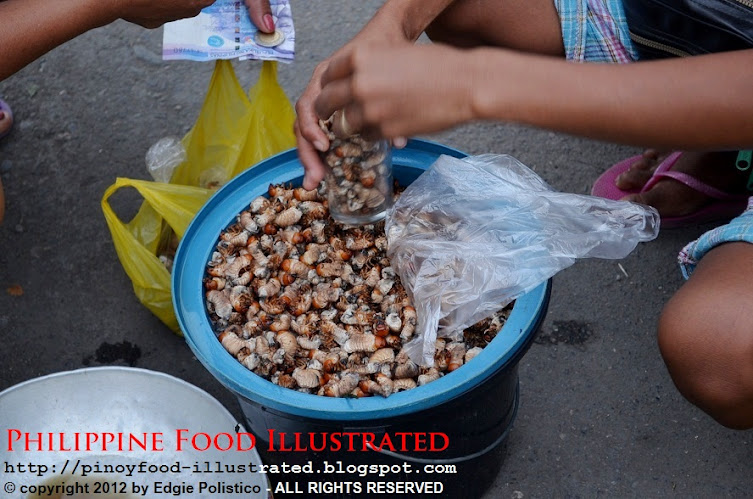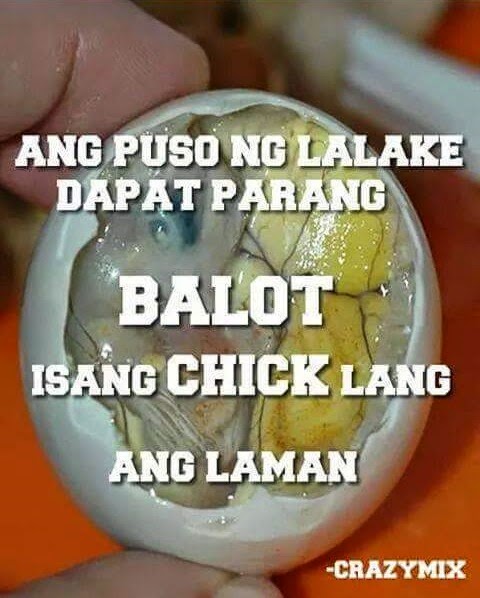If the chick in the egg is still to be hatched, as in between 20 to 21 days of incubation period, the eggs are prematurely cracked open and the chicks are removed from the shells. The chicks are then parboiled to easily remove visible hairs and then fried in deep oil until crisp and reddish or brownish-orange in color.
Fried one-day-old chicks are served either skewered in bamboo sticks or put in a plastic cups and drenched in spiced-up vinegar or sweet brown sauce.
A gruesome story behind one-day-old chicks.
Did you know that the major source of one-day-old chicks delicacy are culled male chicks from the egg farms?
It is a practice for poultry producers that they would favor to grow female chicken for meat as they grow faster. They would routinely and systematically remove the male chicks at the very start of growing the chick in a process known as culling or the harvesting and killing of chicks.
In the industry of growing chickens, chicken farmers would start to cull their chicks out of fear that the cost of poultry production will continue to rise while poultry income would drop due to low farm gate prices or too much overhead expenses.
Poultry farmers would routinely cull male chicks as part of their cost-cutting strategy for poultry production and to increase their return on investment. Male chicks are not grown for meat as they would cost more to feed and house than they would produce income.
Biologically, it is impossible for male chickens to lay eggs as they do not have ovaries where eggs are developed inside the chicken's body. Only female chickens have an ovary and are able to lay eggs. The females could also lay eggs continuously even if there is no male chicken present. Yes, they can spontaneously develop an egg inside their bodies and lay eggs all by themselves. Males have no role in the egg-laying process. The females (hen or pullets) would only need a male (rooster or cockerel) when it comes to fertilizing an egg to produce another batch or next generation of chicks.
Thus, male chicks are deemed worthless in the egg industry and they are mercilessly culled or brutally killed.
Culling usually starts as early as when the undesired chicks are hatched or just a day-old chicks. In big poultry farms, chicks are routinely culled by shredding them alive, though some farmers would electrocute, suffocate in bags, or gas the chicks to death before macerating them. Some would resort to brutal killing by using extremely cruel techniques of shredding chicks alive, burning, crushing, drowning, electrocuting, gassing using CO2 gas, or suffocating them in bags.
In 2021, it was reported that a total of more than 6 billion chicks are killed every year around the world by industrial farmers as they are considered useless by both egg and chicken meat producers.
However, in the Philippines, culled chicks are sold to street food entrepreneurs who would then fry the chicks in oil and sold as a delicacy.
The advancing technology of eliminating male chicks.
Even when in-ovo sexing technology is implemented to help abolish the culling of male chicks, as what the animal welfare activists are lobbying for, Philippine's one-day-old chicks delicacy will not totally disappear in the food map. In-ovo sexing is just a process of determining the sex of a chicken before the egg hatches. Thus, fully developed chicks are still there waiting to be cracked open and fried into a "one-day-old chick" Pinoy food delicacy.
What may likely stop male chicks from fully developing and being allowed to hatch and be culled is the use of "endocrinological gender identification" technology, a kind of test similar to a human pregnancy test. It is done during the 8th to 14th day incubation period when a sample of liquid from each fertilized egg is taken and examined for the presence of a female hormone by looking for a color-changing reaction. The female eggs continue toward hatching, while the male eggs will be removed and used for animal feed for us Filipinos, we can boil these eggs and pass them on as the chicken version of balut penoy.
But endocrinological gender identification is far from becoming a normal practice aside from being a very costly process. There is an issue that complicates this process - that it is uncertain when an embryo becomes a chick to feel pain. Some researchers say chick embryos can begin to experience pain at day 7 of incubation. If true, sexing the eggs 8 to 14 days after incubation would end up trading animal welfare problems even if electricity is used to help anesthetize the eggs.
Unless technology is developed that can control and change the sex of chicks before they even hatch, culling male chicks will not stop. The technique could be the use of hormonal treatments, where the future fertilized egg will permanently produce all-female laying-breed chicks. From then, culling chicks will be eliminated and one-day-old chicks may start to dwindle and disappear in the street food markets.











%2B-%2Bwatermarked.jpg)










